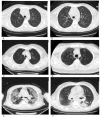Predicting Severity of Novel Coronavirus (COVID-19) Pneumonia based upon Admission Clinical, Laboratory, and Imaging Findings
- PMID: 35382076
- PMCID: PMC8978039
Predicting Severity of Novel Coronavirus (COVID-19) Pneumonia based upon Admission Clinical, Laboratory, and Imaging Findings
Abstract
Background: The purpose of this study was to investigate the prognostic factors in hospitalized COVID-19 pneumonia patients according to the baseline clinical, laboratory, and imaging manifestations.
Materials and methods: In this retrospective study on the SARS-CoV-2 laboratory-confirmed cases, clinical and laboratory data were collected from 156 hospitalized patients during August to October, 2020. Baseline chest CT was assessed, and the CT severity score was then calculated. Data were compared between the two groups of patients with moderate and severe/critical conditions.
Results: Of the 156 participants with the age range of 25-95 years (56.87±16.88), 70 and 86 patients were in the moderate and severe/critical groups, respectively. Most patients had typical imaging features on chest CT. Compared to the moderate group, the severe/critical group were older and were mainly suffering from underlying comorbidities. The rate of confusion on admission (P=0.008) and pulse rate≥100 (p=0.04) were significantly higher in the severe/critical group. According to the CT manifestations, consolidation, central and diffuse peripheral and central distribution, patchy/segmental morphology, crazy paving pattern, pleural effusion, aorta, and coronary artery calcification were more likely to emerge in the severe/critical group (p<0.05). In contrast, round/nodular morphology mainly appeared in the moderate group (p= 0.002). The chest CT severity scores were 10.24±7.91 and 6.13±4.42 in the severe/critical and moderate groups, respectively, indicating statistically significant values.
Conclusion: The clinical, laboratory, and chest CT findings can be used for the prognosis of COVID-19 pneumonia. Predicting the outcomes for the patients on admission can play a critical role in decision making.
Keywords: COVID-19; Pneumonia; Prognosis; Respiratory infections.
Copyright© 2021 National Research Institute of Tuberculosis and Lung Disease.
Figures


References
-
- Murray PR, Rosenthal KS, Pfaller MA. Medical Microbiology. Elsevier Health Sciences, https://books.google.ca/books?id=Gx3mCgAAQBAJ (2015).
-
- WHO . Naming the coronavirus disease (COVID-19) and the virus that causes it, https://www.who.int/emergencies/diseases/novel-coronavirus-2019/technica....
-
- WHO . Coronavirus disease 2019 (COVID-19). Situation Report 51, https://www.who.int/docs/default-source/coronaviruse/situation-reports/2... (11 March 2020).
LinkOut - more resources
Full Text Sources
Miscellaneous
